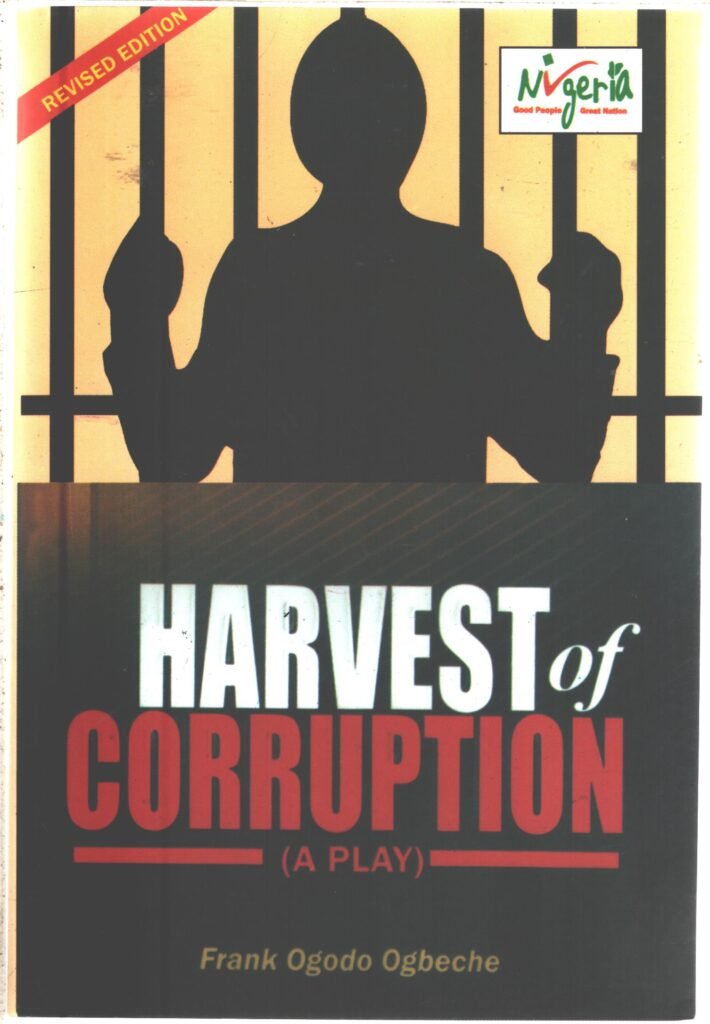“Harvest of Corruption” by Frank Ogodo Ogbeche is a powerful play that delves into themes of greed, corruption, societal decay, and the struggle for justice in a fictional African society called Jacassa. Written with a gripping narrative and relatable characters, it serves as a mirror reflecting the realities of many developing nations. Below is an in-depth exploration of the themes, class activities, and assignments to better understand and engage with this remarkable literary work.
10 Themes in Harvest of Corruption
1. Corruption
The play’s central theme revolves around corruption. It exposes the prevalence of unethical practices in public offices, with Chief Haladu Ade-Amaka embodying the misuse of power for personal gain. The narrative highlights the devastating impact of corruption on individuals and society.
2. Greed
Greed motivates many characters, particularly Chief Ade-Amaka, whose insatiable desire for wealth and power drives his corrupt practices. His greed is a catalyst for the societal decay depicted in the play.
3. Injustice
The play portrays a justice system that often favors the powerful while marginalizing the weak. Aloho’s struggles exemplify how the powerless suffer in the face of institutionalized injustice.
4. Abuse of Power
Chief Ade-Amaka’s position as a government official is misused to exploit others and enrich himself. This abuse underscores the dangers of unchecked authority.
5. Moral Decay
Jacassa’s society reflects moral decline, with characters like Aloho succumbing to illegal activities out of desperation, and others perpetuating corruption for selfish reasons.
6. Redemption and Accountability
The play underscores the possibility of redemption and the importance of holding corrupt individuals accountable. The downfall of Chief Ade-Amaka symbolizes the triumph of justice.
7. Poverty and Desperation
Economic hardship drives characters like Aloho to make questionable decisions. Poverty is portrayed as both a cause and a consequence of corruption.
8. Exploitation of Women
The play sheds light on gender dynamics and the exploitation of women, as seen in Aloho’s plight. Her vulnerability is exploited by the corrupt system.
9. Religious Hypocrisy
Some characters use religion as a facade to cover their immoral actions. This theme critiques the misuse of religion for personal gains.
10. Hope and Justice
Despite the grim portrayal of corruption, the play ends on a hopeful note. Justice prevails, signaling that societal change is possible when people stand against corruption.
5 Class Activities
- Character Roleplay:
- Assign students different roles from the play and have them act out key scenes. This will help them understand character motivations and relationships.
- Debate Session:
- Divide the class into two groups to debate whether societal change begins with individuals or institutions, referencing the play’s themes.
- Theme Analysis Groups:
- Organize students into groups to analyze specific themes and present their findings to the class. For instance, one group can explore corruption while another focuses on gender dynamics.
- Creative Writing Exercise:
- Ask students to write an alternative ending to the play. This encourages creativity and deeper engagement with the plot.
- Scene Illustration:
- Students can create visual representations (drawings or sketches) of their favorite scenes, highlighting the emotions and themes involved.
5 Class Assignments
- Essay Writing:
- Write a 500-word essay on how Frank Ogodo Ogbeche portrays the consequences of corruption in Harvest of Corruption.
- Character Analysis:
- Analyze the character of Aloho, focusing on her strengths, weaknesses, and her role in advancing the play’s themes.
- Thematic Essay:
- Discuss how poverty contributes to corruption, using examples from the play and real-life scenarios.
- Dialogue Rewrite:
- Rewrite a significant dialogue from the play in modern language, maintaining its original meaning but making it relatable to today’s audience.
- Research Assignment:
- Research real-life instances of corruption in a chosen country and compare them with the events in Harvest of Corruption.

